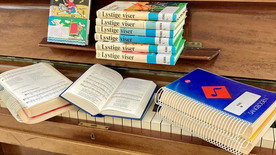
Innovative Learning Environments – Then, Now, and Next?
Det Kongelige Akademi
Danneskiold-Samsøes Allé 51
København K
Danmark
To forelæsninger om forskning, design og brug af innovative læringsmiljøer: I Island og Australien designes nyt skolebyggeri oftest som innovative læringsmiljøer. Men hvad forstår vi egentlig ved innovative læringsmiljøer? Hvad ved vi om, hvordan de virker? Og ikke mindst, hvad ved vi ikke?
På basis af mange års forskning i læringsmiljøer fortæller Professor Anna Kristín Sigurðardóttir (University of Iceland) og Associate Professor Wesley Imms (University of Melbourne) & Senior Researcher Julia Morris (Edith Cowan University) om den nyeste forskning i design af og praksis i innovative læringsmiljøer, herunder overgangen fra traditionelt klasselokale til innovative læringsmiljøer i hhv. Island og Australien.
The lectures will be in English.
Program
14.30 Welcome
/ Assistant Professor Bodil Hovaldt Bøjer, Royal Danish Academy - Institute of Visual Design
14.35-15.15 Innovative environment for innovative pedagogy
/ Professor Anna Kristín Sigurðardóttir, University of Iceland
There is a broad agreement in the literature that there is no innovative physical learning environment without innovative pedagogy. In the presentation the link between those two is discussed with reference to recent development of the design of school building in Iceland. Around the last millennium a policy effort was made to create a learning environment for student-centred learning and increased teacher collaboration. This effort has affected the design of new school buildings, moving from the traditional classrooms of similar size along corridor toward more open and flexible learning spaces. It is, however, debatable to what extend Icelandic teachers and school leaders managed to adapt the pedagogy into these so-called innovative buildings.
15.15-15.30 Break
15.30-17.00 Challenges for ILE research: Then, now, and next
/ Associate Professor Wesley Imms, University of Melbourne & Senior Researcher Julia Morris, Edith Cowan University, Australia.
Through examples of practice and evidence gained across the past few years, the presenters bring an Australian perspective about the status of research into innovative learning environments (ILEs), inviting comparisons to be made on how this could inform European circumstances. It discusses historical and recent evidence that informs decisions about the design and use of ILEs (the ‘then’). It draws on recent and emerging data to present our thoughts on demands being asked of ILE research (the ‘now’). It hypothesises the future, the ways we can leverage off the past and present to make ILE research a powerful tool for improving quality of education (the ‘next’).
17.00 Mingling and drinks











